
Court House Square is the location of Charleston County Courthouse in downtown Charleston, South Carolina, at the intersection of Meeting and Broad Streets. It is historically known as "the Four Corners of Law" because the intersection hosted buildings from each level of government: the Courthouse, City Hall, the Federal Building and U.S. Post Office, and Saint Michael's Episcopal Church.

The Charleston Museum is a museum located in the Wraggborough neighborhood in Charleston, South Carolina. It is one of the oldest museums in the United States. Its highly regarded collection includes historic artifacts, natural history, decorative arts and two historic Charleston houses.
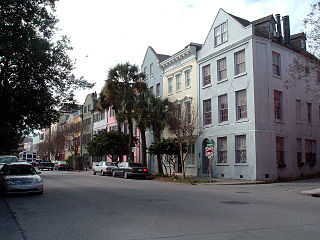
Rainbow Row is the name for a series of thirteen colorful historic houses in Charleston, South Carolina. It represents the longest cluster of Georgian row houses in the United States. The houses are located north of Tradd St. and south of Elliott St. on East Bay Street, that is, 79 to 107 East Bay Street. The name Rainbow Row was coined after the pastel colors they were painted as they were restored in the 1930s and 1940s. It is a popular tourist attraction and is one of the most photographed parts of Charleston.

St. Mary of the Annunciation Roman Catholic Church is the first Roman Catholic parish in the Carolinas and Georgia. The current building at 93 Hasell St. in Charleston, South Carolina, is the third structure to house the congregation on this site.

The William Seabrook House, also known as the Seabrook is a plantation house built about 1810 on Edisto Island, South Carolina, United States, southwest of Charleston. It is located off Steamboat Landing Road Extension close to Steamboat Creek about 0.7 mi (1.1 km) from Steam Boat Landing. It was named to the National Register of Historic Places on May 6, 1971.

First Baptist Church is a historic Baptist church in Charleston, South Carolina. The congregation was founded in 1682 under the leadership of William Screven. It is one of the oldest Baptist congregations in the American South. The church congregation was originally organized in Kittery, Maine under the guidance of the First Baptist Church of Boston. In 1696 twenty-six congregants followed Pastor Screven and moved to Charleston after being pressured by the New England Congregationalist authorities. The relocated congregation became the First Baptist Church of Charleston. Pastor Screven recommended that future any future pastor be "orthodox in faith, and of blameless life, and does own the confession of faith put forth by our brethren in London in 1689" declaring the church to be firmly Calvinist. First Baptist Church is currently affiliated with the Southern Baptist denomination. The current Greek Revival sanctuary was designed by Robert Mills and built in 1820.

Pink House is a historic house and art gallery at 17 Chalmers Street in Charleston, South Carolina that is one of the oldest buildings in South Carolina and is the second oldest residence in Charleston after the Colonel William Rhett House.

Tristram Hyde House is a historic two-story home in Charleston, South Carolina constructed in 1914 for Tristram Hyde, who soon after became mayor of Charleston in 1915. It was designed by local architect Albert Wheeler Todd.
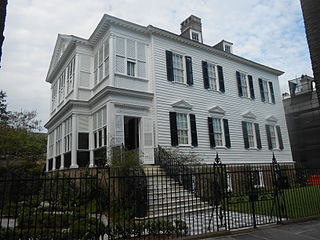
The William Washington House is a pre-Revolutionary house at 8 South Battery, Charleston, South Carolina. It is the only pre-Revolutionary house on Charleston's Battery. Thomas Savage bought the lot at the southwest corner of Church St. and South Battery in 1768 and soon built his house there. The resulting structure is a nationally important, Georgian style, square, wooden, two-story house on a high foundation.

The Charles Graves House is a three-story brick residence constructed for Charles Graves at 123 Tradd Street in Charleston, South Carolina. The roof has a hip in it and the details exhibit styling of the Federal architecture period.

The Patrick O'Donnell House is the largest example of Italianate architecture in Charleston, South Carolina. It was built for Patrick O'Donnell (1806-1882), perhaps in 1856 or 1857. Other research has suggested a construction date of 1865. Local lore has it that the three-and-a-half-story house was built for his would-be bride who later refused to marry him, giving rise to the house's popular name, "O'Donnell's Folly." Between 1907 and 1937, it was home to Josephine Pinckney; both the Charleston Poetry Society and the Society for the Preservation of Spirituals were formed at the house during her ownership.

The James Simmons House is a late 18th-century house at 37 Meeting Street, Charleston, South Carolina which was, at one time, the most expensive house sold in Charleston. It was likely built for James Simmons, a lawyer. By 1782, it was home to Robert Gibbes, a planter. Louisa Cheves, a prominent antebellum writer, was born at the house on December 3, 1810. In 1840, Otis Mills, the owner of the Mills House Hotel, bought the house for $9,000. In October 1862, during the Civil War, the house was loaned to Gen. Pierre Beauregard, who used the house as his headquarters until August 1863. In 1876, Michael P. O'Connor, later a member of Congress, bought the house.
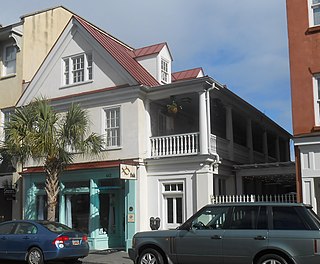
The James Ferguson House at 442 King St., Charleston, South Carolina, is an antebellum house dating to at least 1840 that is being used as a restaurant.

The Robert Gibbes House in Charleston, South Carolina, was built in the Adamesque style at least by the time Robert Gibbes, Jr. was occupying it in 1819, perhaps earlier.

The Col. John A.S. Ashe House is a historic home in Charleston, South Carolina along Charleston's Battery. Col. John A.S. Ashe, Jr. received the property upon which 26 South Battery is built upon his father's death in 1828 along with $10,000 for the construction of a house. Col. John A.S. Ashe, Jr.'s father had built the nearby Col. John Ashe House at 32 South Battery in the 1780s.

The John Bickley House is an early 19th-century house at 64 Vanderhorst St., Charleston, South Carolina. The construction date for the house has been the subject of debate for many years, but the current consensus places the date as after 1824. John Bickley bought the property upon which the house stands in 1824 for $707.94, and in 1826, the house was placed in a trust for his wife, Mary Desel. The low price for the large lot and the transfer to the trust suggest that the house was built for Bickley. Bickley was a lumber factor who also planted rice at Woodstock Plantation in Goose Creek, South Carolina. The two-and-a-half-story Flemish bond, brick house sits on a high basement with a two-story piazza along the south facade that wraps to each side. In both interior and exterior details, the house reflects the Regency style.
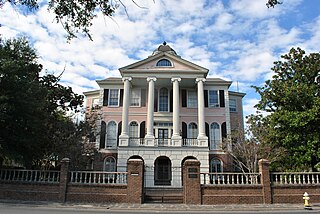
The Faber-Ward House is a historic three-story home in Charleston, South Carolina. Henry F. Faber built the house about 1832 in a Palladian style reminiscent of Southern plantations. The house was converted into a hotel for African-Americans after the American Civil War and then a middle-class residence.

The John Drayton House is a two-story wooden residence constructed on property that had been given by the state's first lieutenant governor, William Bull, to his son-in-law, John Drayton. The house was built, probably by John Drayton, some time after 1746 with alterations made in about 1813 and again in about 1900. Over time, the house has been attributed to different owners; during most of the 20th century, the house was credited to James Shoolbred, the first British consul in Charleston, with a construction date of about 1793.
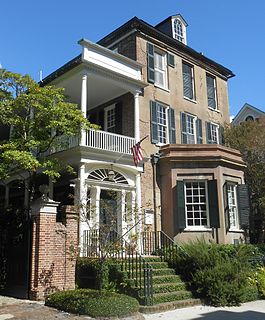
The Robert Pringle House is a historic house in Charleston, South Carolina.
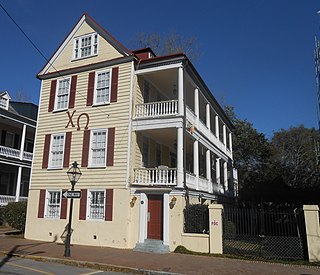
The John Scott House at 38 Coming Street is one of the two oldest buildings on the Charleston, South Carolina campus of the College of Charleston.




















